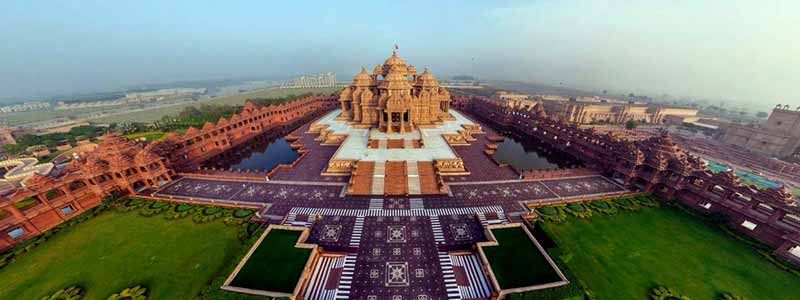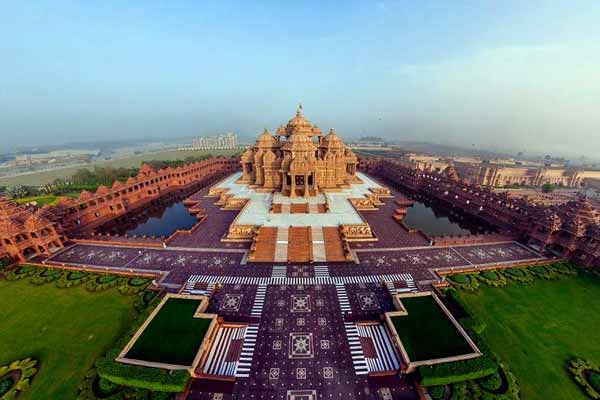Akshardham Temple Delhi is a spiritual complex nestled in New Delhi and is a popular Hindu temple of Delhi. This marvelous temple was constructed in the year 2005 at Noida Mor region of New Delhi and is referred as Akshardham Temple of Swaminarayam Akshardham. The term Akshardham is the combination of two words ‘Akshar’ means ‘eternal’ and ‘Dham’ means ‘abode’. On a whole it actually means the abode of eternal values, virtues and principles which are mentioned in Vedas and Puranas of Hindu mythology.
Apart from all this, the complex of Akshardham Temple in Delhi displays numerous traditional aspects, beautiful architecture, Indian culture and spirituality. In the centre the main complex is built on the principles of Vastu Shastra and Pancharatra Shashtra which is called as Akshardham Temple Delhi.
Akshardham Temple of Delhi is one of the prime attractions in Delhi where one can witness exclusive architectural charm with more than 234 beautifully carved pillars, 9 elaborate domes, 20 quadrangle spires and 20000 sculptures of spiritual personalities from India. It is one of the major attractions for history buffs and art lovers as one can here easily enjoy intricate art and flawless craftsmanship. Moreover, the whole temple is build using Italian Carrara marble and pink sandstone. So, when are you planning your visit to this popular temple of Delhi?

History of Akshardham Temple Delhi
Akshardham Temple Delhi was officially opened to public on 6th November 2005. It was inaugurated by president of India late Dr. A.P.J. Abdul Kalam. It took around 5 years of time to build the entire Swaminarayan Akshardham complex as per the ancient methods such as Vastu shastra and Pancharatra shastra Delhi Tour Packages.
Located on the banks of River Yamuna, this temple is close to the 2010 Commonwealth Games village. The idea of temple complex was conceived by Yogiji Maharaj around 1968, the then spiritual head of BAPS. Later in 1982, his successor Pramukh Swami Maharaj started the work towards the construction of Akshardham complex.
In 2000, 60 acres and 30 acres of land were offered by Delhi Development Authority and Uttar Pradesh government respectively for the project. In the month of November 2000, the construction for the temple complex was started which was completed in about 5 years. It was then officially opened in November 2005. The inauguration function was attended by the then Prime Minister of India Mr. Manmohan Singh and leader of opposition Mr. L.K Advani as well.
Akshardham Temple Delhi has also been bestowed with Guinness world record for being the largest comprehensive Hindu Temple in the world.
Architecture of Akshardham Delhi
Constructed with pink sandstone and marble, Akshardham Temple Delhi is the centre of the Swaminarayan Akshardham complex. The vast complex of Swaminarayan Akshardham Delhi comprises of the main temple, beautifully laid out gardens, exhibitions, open courtyards and water bodies, each section presenting an intriguing aspect of Hindu religion and spirituality Delhi Monuments.
Built in the traditional Hindu architectural style, Akshardham Delhi has been built as per ancient Indian architecture. It follows the traditional Vastu shastra as well as Pancharatra Shastra. Mandir and the entire complex display intricate carvings of flowers, animals, musicians, dancers and Hindu deities. The material used in constructing the temple – red sandstone from Rajasthan and the Italian Carrara marble, presents an alluring contrast which adds to the overall beauty of the structure. For the construction, more than 6,000 tons of pink sandstone was brought from Rajasthan.
Akshardham Temple- It stands majestically with a height of 141.3 feet and is spread with a width of 316 feet. It comprises of around 234 pillars that have been carved beautifully. It has 9 elaborately adorned domes along with 20 quadrangle peaks. There are around 20,000 idols related to Hinduism at the temple. The main statue of Swaminarayan is 11 foot long, and is placed under the central dome. The main deity is surrounded by statutes of other great sages. There are also statues of other Hindu Gods and Goddess. Each statue at the Akshardham Mandir has been constructed with five metals known as panch dhaatu.
Gates at Akshardham – The first thing to greet you at Akshardham Temple Delhi are the majestic gates. There are 10 gates which are symbolic of 10 directions. As per Hindu beliefs these ten gates symbolizes accepting good from all directions so as to nurture the feeling of oneness and peace in the world.
Visitors pass through Bhakti Dwar, also known as Gate of Devotion to enter the Akshardham Delhi. From here, they enter the Visitor Center. There are two Mayur Dwars also known as Peacock Gates. Between these two Mayur Gates is the ‘Charnarvind’. It is a huge replica of the footprints of Bhagwan Swaminarayan. It is built in marble and has water showers from all four sides. The holy footprints also comprise of 16 holy symbols.
How to reach Akshardham Temple
Akshardham Mandir Delhi is easily accessible from all the parts of the city. It is well connected via public transport ranging from government run buses to metro railways. The nearest metro station to the Swaminarayan Akshardham Delhi is Akshardham Metro Station on the Blue line which is only 350 meters away. Hence, tourists can get down at this station and walk to the temple. If interested, one can also hire an auto rickshaw to the temple in minimum fare.
If coming via Yellow line of Delhi Metro, one needs to get down at Rajiv Chowk metro station and then board a metro train towards Akshardham temple on the Blue line.
The distance from Delhi Airport to Akshardham Temple is around 21 km which can be covered within 1 and half hours of time. The common route to the temple from the airport is via Thimayya Marg.
If you are travelling from Gurgaon, then you will require around 2 hours or slightly more than that to reach the temple. Gurgaon to Akshardham Temple distance is about 43 km while Delhi to Akshardham distance is 31 km which can be covered in 1 hour of time via NH9.
From Karol Bagh to Akshardham temple it takes around 50 minutes of time as the distance between the two is about 12.6 km.
